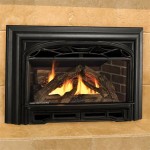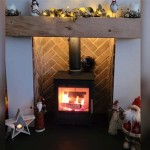Cleaning a Brick Fireplace: A Comprehensive Guide
A brick fireplace serves as a focal point in many homes, providing warmth and aesthetic appeal. However, the soot, ash, and creosote resulting from burning wood can accumulate over time, diminishing its beauty and potentially posing fire hazards. Regular cleaning is essential to maintain the fireplace's appearance and ensure its safe operation. This article provides a detailed guide to cleaning a brick fireplace, covering preparation, cleaning methods, and preventative measures.
Preparation for Cleaning
Before initiating the cleaning process, thorough preparation is crucial. This step minimizes mess, protects surrounding areas, and ensures the cleaning process is both efficient and effective.
First, gather the necessary cleaning supplies. Essential items include a stiff-bristled brush (preferably with nylon bristles to avoid scratching the brick), a vacuum cleaner with a hose attachment, a bucket, trisodium phosphate (TSP) or a TSP substitute, water, rubber gloves, eye protection, and drop cloths or plastic sheeting. Gentle dish soap can also be used as a TSP alternative if the soot buildup is not severe.
Next, protect the surrounding area. Cover the floor and any nearby furniture with drop cloths or plastic sheeting. Secure the covering with tape to prevent slippage. This is especially important for carpets, hardwood floors, and delicate surfaces that could be stained or damaged by cleaning solutions.
Ventilation is paramount. Open windows and doors to ensure adequate airflow, minimizing the inhalation of dust and fumes from cleaning agents. Consider using a fan to circulate air and expedite the drying process after cleaning.
Prior to commencing the main cleaning process, remove loose debris from the fireplace. Use the vacuum cleaner with the hose attachment to remove loose ash, soot, and any other debris from the firebox and surrounding brick surfaces. This initial vacuuming will prevent the dirt from being spread around during the cleaning process.
Inspecting the brick and mortar for any damage is also a crucial preparatory step. Look for cracks, crumbling mortar, or loose bricks. Address structural issues before cleaning to prevent further damage and ensure the fireplace's integrity.
Cleaning Methods for Brick Fireplaces
Several methods can be employed to clean a brick fireplace, depending on the severity of the soot buildup and the type of cleaning solution used. The most common and effective methods are outlined below.
The first method involves using a TSP solution. Trisodium phosphate is a powerful cleaning agent effective for removing stubborn stains and soot. However, it can be harsh on skin and surfaces, so appropriate safety precautions are necessary. Prepare a solution by mixing TSP with water according to the manufacturer's instructions, typically about half a cup of TSP per gallon of warm water.
Before applying the TSP solution to the entire fireplace, test it on an inconspicuous area to ensure it does not damage or discolor the brick. Apply the solution to a small area and let it sit for a few minutes, then rinse with clean water and observe the results. If there is no adverse reaction, proceed with cleaning the entire fireplace.
Dip the stiff-bristled brush into the TSP solution and scrub the brick surfaces, focusing on areas with heavy soot buildup. Apply moderate pressure and use a circular motion to loosen the soot. Work in small sections and rinse each section thoroughly with clean water after scrubbing. Prevent the cleaning solution from drying on the brick, as this can leave a residue.
For stubborn stains, create a paste by mixing TSP with a small amount of water to form a thick consistency. Apply the paste directly to the stained area, let it sit for several minutes, and then scrub vigorously with the brush. Rinse thoroughly with clean water.
An alternative method involves using a vinegar and baking soda paste. This is a more natural and less harsh cleaning solution. Mix equal parts baking soda and white vinegar to create a paste. The mixture will fizz, so use a container large enough to accommodate the reaction.
Apply the baking soda and vinegar paste to the brick surfaces, focusing on the areas with soot and stains. Let the paste sit for about 15-20 minutes to allow the baking soda to penetrate the soot. Scrub the brick with a stiff-bristled brush and rinse thoroughly with clean water.
Another option is to use commercial brick cleaners. Numerous commercial brick cleaners are available, designed specifically for removing soot and stains from brick surfaces. Follow the manufacturer's instructions carefully when using these products. Ensure that the cleaner is compatible with the type of brick in the fireplace.
Regardless of the cleaning method used, thorough rinsing is essential. After scrubbing the brick, rinse the entire surface with clean water to remove any remaining cleaning solution. Use a sponge or cloth dampened with water to wipe down the brick and ensure all traces of the cleaning agent are removed. Failure to rinse thoroughly can leave a residue that attracts dirt and soot.
After rinsing, allow the brick to dry completely. Open windows and use fans to expedite the drying process. Ensure the brick is completely dry before using the fireplace again.
Preventative Measures and Maintenance
Preventing soot buildup and maintaining a clean fireplace is easier than repeatedly tackling heavy soot deposits. Implementing preventative measures and regular maintenance can significantly reduce the frequency and intensity of cleaning required.
One of the most effective preventative measures is to burn seasoned wood. Seasoned wood has a lower moisture content than green wood, resulting in a cleaner, more efficient burn. Burning green wood produces more smoke and creosote, which contribute to soot buildup. Store firewood in a dry, covered location to keep it seasoned.
Regular chimney sweeping is also crucial. A professional chimney sweep can remove creosote and soot buildup from the chimney flue, preventing chimney fires and ensuring proper ventilation. It is generally recommended to have the chimney inspected and cleaned at least once a year, or more frequently if the fireplace is used heavily.
Proper airflow during burning minimizes soot production. Ensure the fireplace damper is fully open during use to allow for adequate ventilation. A properly functioning damper also prevents drafts when the fireplace is not in use.
Maintain the firebox by regularly removing ash after each use. Use a shovel and a metal container to remove the ash, taking care to avoid creating dust. Dispose of the ash properly, ensuring it is completely cool before placing it in a non-combustible container. Avoid vacuuming hot ash, as this can damage the vacuum cleaner and pose a fire hazard.
Applying a brick sealant can protect the brick surface from stains and make future cleaning easier. Brick sealants create a barrier that prevents soot and moisture from penetrating the brick pores. Before applying a sealant, ensure the brick is clean and dry. Follow the manufacturer's instructions for application. Reapply the sealant periodically as needed.
When cleaning the brick fireplace, prioritize the mortar joints. Mortar is more porous than brick and tends to absorb more soot and stains. Use a brush with firm bristles to clean the mortar joints effectively. Avoid using excessive pressure, as this can damage the mortar. If the mortar is crumbling or damaged, consider having it repaired or replaced by a professional.
Consistent cleaning schedule, even if it's a light wipe-down after each use, will prevent the build-up of stubborn soot. A quick wipe with a damp cloth can remove fresh soot before it has a chance to settle and harden.
Consider using fire starters that burn cleanly. Some fire starters produce more smoke and residue than others. Opt for fire starters that are designed to burn cleanly and efficiently, minimizing soot production.
By implementing these preventative measures and following a regular maintenance schedule, homeowners can significantly reduce the amount of soot buildup in their brick fireplaces, making cleaning easier and ensuring the fireplace remains a beautiful and functional feature of their homes.

How To Clean Fireplace Bricks Simple Practical Beautiful Brick

How To Clean A Fireplace Diy Basics

How To Clean Fireplace Bricks 9 Steps With S Wikihow

How To Create An Exposed Brick Feature Wall Or Fireplace And Clean Maintain It Like Expert Manchester Evening News

How To Clean A Sooty Fireplace With Household Items Brick House Cleaning Tips
:max_bytes(150000):strip_icc()/how-to-clean-fireplace-bricks-4587771-04-41cf6d2d0dbf40e88738bf54012079ba.jpg?strip=all)
Fireplace Maintenance Checklist 12 Tips For Wood Burning Fireplaces

How To Clean Brick The Home Depot

Wood Fireplace Brick Cleaner Removes Soot Ash Friendly Fires

How To Clean Brick Fireplace Royal Stone Care

How To Clean Brick The Home Depot
Related Posts








